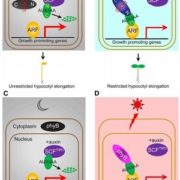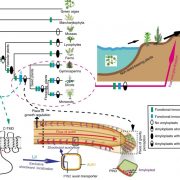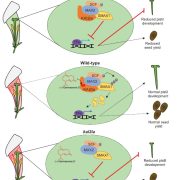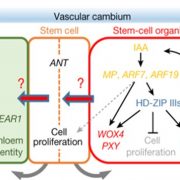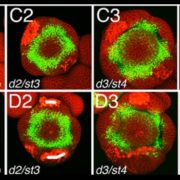Contribution of strigolactones to maize kernel domesticated phenotype
 We’ve all seen striking photographs comparing the modern maize (Zea mays spp. mays L.) ear to the seed head of its wild-grass ancestor teosinte (Zea mays spp. parviglumis). Besides the huge increase in size, one of the features that allows us to munch on “corn on the cob” is the absence of the hard, shell-like coverings on each kernel. Previous work identified Teosinte glume architecture 1 (Tga1), a gene that has a role in this domestication and encodes a SPL-type transcription factor. Maize carries a dominant gain-of-function mutation in Tga1 that has pleiotropic effects but does not alone account for the differences in maize and teosinte ear structures. Here, Guan et al. describe the additional involvement of strigolactone hormones in maize ear formation. They looked at strigolactone synthesis mutants (ccd8), in which several facets of maize development including ear formation are affected; in many ways, the SL-deficient maize ears, particularly when combined with the ancestral tga1 allele, strongly resemble those of teosinte. As the authors report, these SL-mediated effects occur both through interactions with TGA1 (via protein sequestration) and independently. They conclude that “SLs have central roles in releasing kernels from restrictive maternal encasement and coordinating other factors that increase kernel size, physical support, and their exposure on the grain-bearing surface.” (Summary by Mary Williams @PlantTeaching) Plant Cell 10.1093/plcell/koac370
We’ve all seen striking photographs comparing the modern maize (Zea mays spp. mays L.) ear to the seed head of its wild-grass ancestor teosinte (Zea mays spp. parviglumis). Besides the huge increase in size, one of the features that allows us to munch on “corn on the cob” is the absence of the hard, shell-like coverings on each kernel. Previous work identified Teosinte glume architecture 1 (Tga1), a gene that has a role in this domestication and encodes a SPL-type transcription factor. Maize carries a dominant gain-of-function mutation in Tga1 that has pleiotropic effects but does not alone account for the differences in maize and teosinte ear structures. Here, Guan et al. describe the additional involvement of strigolactone hormones in maize ear formation. They looked at strigolactone synthesis mutants (ccd8), in which several facets of maize development including ear formation are affected; in many ways, the SL-deficient maize ears, particularly when combined with the ancestral tga1 allele, strongly resemble those of teosinte. As the authors report, these SL-mediated effects occur both through interactions with TGA1 (via protein sequestration) and independently. They conclude that “SLs have central roles in releasing kernels from restrictive maternal encasement and coordinating other factors that increase kernel size, physical support, and their exposure on the grain-bearing surface.” (Summary by Mary Williams @PlantTeaching) Plant Cell 10.1093/plcell/koac370


